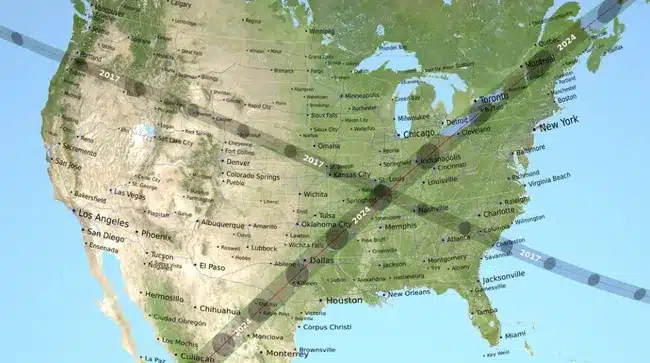The celestial spectacle of a total solar eclipse, captivating in its rarity and grandeur, is set to unfold once again, promising a breathtaking display of cosmic alignment and natural wonder. As we anticipate the upcoming event slated for April 8, 2024, it’s worth reflecting on the nuances that distinguish this impending eclipse from its predecessor in 2017.
In 2017, a memorable coast-to-coast journey of the moon’s shadow swept across 14 U.S. states, marking the first such occurrence in nearly a century. Fast forward to 2024, and we find ourselves on the brink of another celestial rendezvous, this time witnessing the sun’s vanishing act from southwest to northeast. The path of totality, the narrow corridor where the moon completely obscures the sun, will stretch wider this time, encompassing approximately 115 miles compared to the 70 miles witnessed in 2017.
Beyond the mere geographical trajectory lies a tapestry of celestial mechanics, subtly shaping the character of each eclipse. One pivotal factor lies in the moon’s elliptical orbit, dictating its varying proximity to Earth. In 2017, the moon stood at a distance of 231,155 miles from our planet, while in 2024, it will approach closer, at approximately 223,392 miles. Consequently, the shadow cast by the moon during totality will extend further, enveloping a larger swath of our terrestrial realm.
The interplay of Earth’s rotation and the moon’s orbital path adds another layer of complexity to the spectacle. As Earth pirouettes on its axis, the moon’s shadow traverses our planet at a staggering speed of over 1,500 miles per hour, unfurling from west to east. Yet, the angle of Earth’s tilt, coupled with the orientation of the moon’s orbit, imbues each eclipse with a unique trajectory, altering the perception of motion as observed from different vantage points on Earth’s surface.
Moreover, the impending eclipse in 2024 coincides with a period of heightened solar activity, contrasting with the relative calm of the sun during the 2017 event. As the sun’s magnetic activity reaches its zenith, spectators may witness an amplified display of sunspots and solar prominences during the partial phases of the eclipse, further enriching the celestial spectacle.
Perhaps most intriguingly, the paths of totality from 2017 and 2024 intersect, creating a celestial crossroads in parts of southeastern Missouri, southern Illinois, and western Kentucky. This convergence offers a rare opportunity for denizens of these regions to experience the awe-inspiring phenomenon of totality twice within a span of seven years, underscoring the cyclical rhythm of cosmic events.
As we eagerly await the celestial ballet set to unfold on April 8, 2024, let us marvel at the intricate dance of celestial bodies and cherish the fleeting moments of totality, a testament to the boundless wonders of the cosmos.

